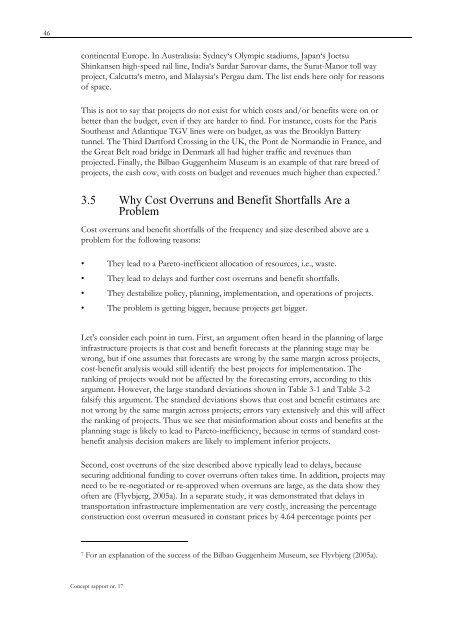How Optimism Bias and Strategic ... - Concept - NTNU
How Optimism Bias and Strategic ... - Concept - NTNU
How Optimism Bias and Strategic ... - Concept - NTNU
Create successful ePaper yourself
Turn your PDF publications into a flip-book with our unique Google optimized e-Paper software.
46<br />
continental Europe. In Australasia: Sydney‘s Olympic stadiums, Japan‘s Joetsu<br />
Shinkansen high-speed rail line, India‘s Sardar Sarovar dams, the Surat-Manor toll way<br />
project, Calcutta‘s metro, <strong>and</strong> Malaysia‘s Pergau dam. The list ends here only for reasons<br />
of space.<br />
This is not to say that projects do not exist for which costs <strong>and</strong>/or benefits were on or<br />
better than the budget, even if they are harder to find. For instance, costs for the Paris<br />
Southeast <strong>and</strong> Atlantique TGV lines were on budget, as was the Brooklyn Battery<br />
tunnel. The Third Dartford Crossing in the UK, the Pont de Norm<strong>and</strong>ie in France, <strong>and</strong><br />
the Great Belt road bridge in Denmark all had higher traffic <strong>and</strong> revenues than<br />
projected. Finally, the Bilbao Guggenheim Museum is an example of that rare breed of<br />
projects, the cash cow, with costs on budget <strong>and</strong> revenues much higher than expected. 7<br />
3.5 Why Cost Overruns <strong>and</strong> Benefit Shortfalls Are a<br />
Problem<br />
Cost overruns <strong>and</strong> benefit shortfalls of the frequency <strong>and</strong> size described above are a<br />
problem for the following reasons:<br />
• They lead to a Pareto-inefficient allocation of resources, i.e., waste.<br />
• They lead to delays <strong>and</strong> further cost overruns <strong>and</strong> benefit shortfalls.<br />
• They destabilize policy, planning, implementation, <strong>and</strong> operations of projects.<br />
• The problem is getting bigger, because projects get bigger.<br />
Let's consider each point in turn. First, an argument often heard in the planning of large<br />
infrastructure projects is that cost <strong>and</strong> benefit forecasts at the planning stage may be<br />
wrong, but if one assumes that forecasts are wrong by the same margin across projects,<br />
cost-benefit analysis would still identify the best projects for implementation. The<br />
ranking of projects would not be affected by the forecasting errors, according to this<br />
argument. <strong>How</strong>ever, the large st<strong>and</strong>ard deviations shown in Table 3-1 <strong>and</strong> Table 3-2<br />
falsify this argument. The st<strong>and</strong>ard deviations shows that cost <strong>and</strong> benefit estimates are<br />
not wrong by the same margin across projects; errors vary extensively <strong>and</strong> this will affect<br />
the ranking of projects. Thus we see that misinformation about costs <strong>and</strong> benefits at the<br />
planning stage is likely to lead to Pareto-inefficiency, because in terms of st<strong>and</strong>ard costbenefit<br />
analysis decision makers are likely to implement inferior projects.<br />
Second, cost overruns of the size described above typically lead to delays, because<br />
securing additional funding to cover overruns often takes time. In addition, projects may<br />
need to be re-negotiated or re-approved when overruns are large, as the data show they<br />
often are (Flyvbjerg, 2005a). In a separate study, it was demonstrated that delays in<br />
transportation infrastructure implementation are very costly, increasing the percentage<br />
construction cost overrun measured in constant prices by 4.64 percentage points per<br />
7 For an explanation of the success of the Bilbao Guggenheim Museum, see Flyvbjerg (2005a).<br />
<strong>Concept</strong> rapport nr. 17

















